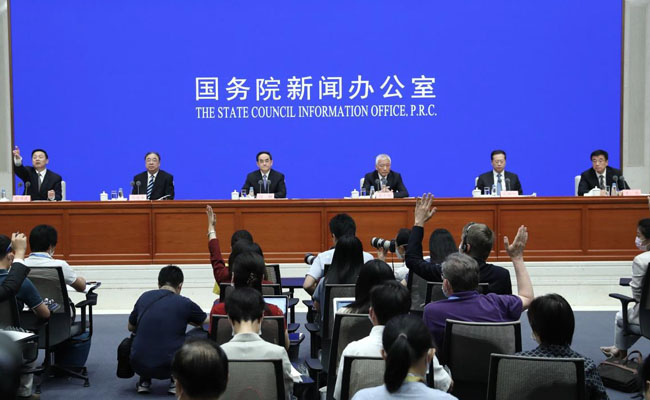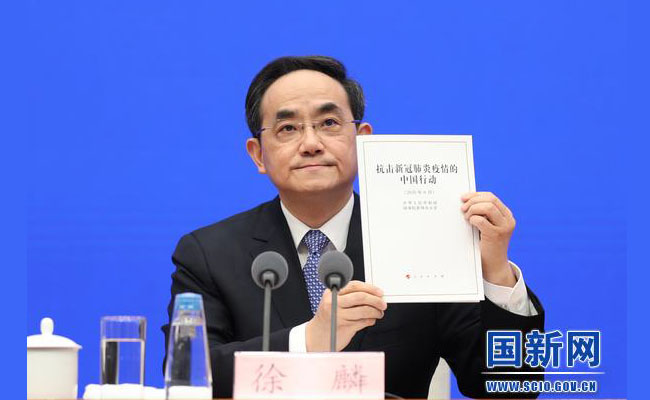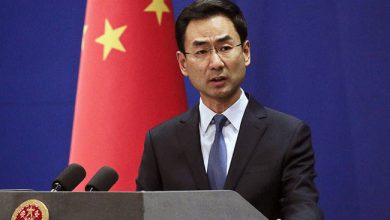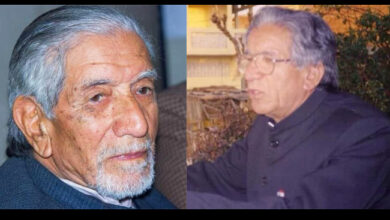White paper on China’s fight against COVID-19

A press conference is held on the publication of a white paper on China’s fight against COVID-19 by the State Council Information Office in Beijing on June 7, 2020.
China publishes white paper on fight against COVID-19 (full text)
BEIJING – China on Sunday issued a white paper on the country’s battle against COVID-19.
The white paper, titled “Fighting COVID-19: China in Action,” was issued by the State Council Information Office.
Besides the foreword and afterword, the white paper consists of four parts: “China’s Fight against the Epidemic: A Test of Fire,” “Well-Coordinated Prevention, Control and Treatment,” “Assembling a Powerful Force to Beat the Virus,” and “Building a Global Community of Health for All.”
Here are the highlights:
Over 94% of COVID-19 patients successfully treated
As of the end of May, a cumulative total of 83,017 confirmed cases had been reported on the Chinese mainland, 78,307 infected had been cured and discharged from hospital, and 4,634 people had died. This demonstrates a cure rate of 94.3 percent.
Temporary treatment centers a major innovative solution
The city of Wuhan re-purposed stadiums and exhibition centers into 16 temporary treatment centers, or Fangcang shelter hospitals, providing some 14,000 beds and making it possible to admit all confirmed mild cases for treatment.
This helped reduce infections and virus transmission in communities and prevent mild cases from worsening.
TCM used in treating 92% COVID-19 cases
Traditional Chinese medicine has been used in treating 92 percent of all confirmed COVID-19 cases across China.
A set of TCM diagnosis and treatment protocols were developed to cover the entire process of medical observation, treatment of mild, moderate, severe and critical cases, and recovery, and they have been applied nationwide.
In Hubei, a province once hardest hit by COVID-19, more than 90 percent of confirmed cases received TCM treatment that proved effective.
China gives COVID-19 patients free treatment
All COVID-19 patients, confirmed or suspected, received subsidies from state finance for any medical bills not covered by basic medical insurance, serious disease insurance, or the medical assistance fund.
As of May 31, the medical bills of 58,000 inpatients with confirmed infections had been settled by basic medical insurance, with a total expenditure of 1.35 billion yuan (about $190 million), or 23,000 yuan per person.
The average cost for treating COVID-19 patients in severe condition surpassed 150,000 yuan, and in some critical cases the individual cost exceeded 1 million yuan, all covered by the state.
Over 3,000 COVID-19 patients aged above 80 cured in Hubei
More than 3,000 COVID-19 patients over the age of 80, including seven centenarians, have been cured in Hubei, the Chinese province once hardest hit by COVID-19.
Many of these cured senior patients were brought back to life from the verge of death. For example, a 70-year-old patient was saved thanks to intensive treatment and care by more than 10 medical workers over a period of several weeks. The cost of his treatment, nearly 1.5 million yuan (around $211,372), was fully covered by the government.
Tailored treatment was given to elderly patients with underlying medical conditions, said the white paper, adding that as long as there was the slightest hope, doctors would never give up, and the need for personnel, medicines, equipment or funds was met.
China launches largest medical assistance operation against COVID-19
China has launched the largest medical assistance operation since the founding of the People’s Republic of China (PRC) to support the COVID-19 fight in Wuhan and other locations in Hubei Province.
From Jan 24 to March 8, China rallied 346 national medical teams, consisting of 42,600 medical workers and more than 900 public health professionals to the immediate aid of Hubei and the city of Wuhan.
The People’s Liberation Army dispatched over 4,000 medical personnel to Hubei to work in epidemic control and sent aircraft to transport emergency medical supplies.
The Chinese government also urgently solicited key medical supplies including negative pressure ambulances and ventilators from across the country for Wuhan and other locations in Hubei.

China establishes strict, efficient COVID-19 information release system
China has established a strict, professional and efficient system of COVID-19 information release amid its all-out effort to contain the epidemic.
China has released authoritative and detailed information as early as possible on a regular basis, thus effectively responding to public concern and building public consensus.
Strict regulations are in place to see there is no withholding of information, underreporting, or delay in reporting cases of infection.
CPC’s strong leadership fundamental to China’s rapid COVID-19 containment
The CPC quickly made the right decisions in response to the crisis and implemented efficient and powerful response measures as it has a strong leadership core, a people-oriented governance philosophy, and well-established organization and operation mechanisms.
Within a short time, across-the-board crisis-response mechanisms were established down to the community level, motivating all those involved across the country to follow instructions and act as one.
Some 4m Chinese community workers guard against COVID-19
During China’s fight against COVID-19, some 4 million Chinese community workers were working in around 650,000 urban and rural communities to guard against the disease.
Dedicated and responsible, they meticulously protected their communities from the virus, taking body temperatures, screening for infection, disseminating government policies, and sanitizing neighborhoods.
Many ordinary people volunteered at the front line, standing guard in communities, screening for infection, carrying out cleaning and disinfection work, and buying medicines and delivering groceries for other residents’ pressing needs.
Preliminary statistics show that as of May 31, 8.81 million registered volunteers across the country had participated in more than 460,000 volunteer projects, rendering a total of more than 290 million hours of voluntary service.
Science, technology underpin China’s COVID-19 fight
China has exploited the pioneering role of science and technology and fully applied the results of scientific and technical innovation in its fight against COVID-19.
The close coordination between scientific research, clinical application, and frontline virus control, and between enterprises, universities and research institutes has given powerful support for the war against the virus.
China initiated 83 emergency research and development programs in such areas as clinical treatment, new medicines and vaccines, testing techniques and products and epidemiology and pooled top research resources around the nation in the programs.
Scientific research and development has been integrated with clinical treatment and epidemic control, highlighting the use of new technologies including big data and artificial intelligence.
China contains COVID-19 rising spread in about 1 month
China has responded swiftly to the COVID-19 public health emergency and the rising spread of the virus was contained in little more than a single month.
As soon as cases of pneumonia of unknown cause were identified in Wuhan City, Hubei province, China acted immediately to conduct etiological and epidemiological investigations and to stop the spread of the disease, and promptly reported the situation.
In a timely manner, China informed the World Health Organization and other countries, including the United States, of the developing situation, and released the genome sequence of the novel coronavirus.
China offers help to 150 countries, 4 int’l organizations to fight COVID-19
China had sent 29 medical expert teams to 27 countries and offered assistance to 150 countries and four international organizations as of May 31.
China has provided two batches of cash support totaling $50 million to the World Health Organization (WHO).
It also assisted the WHO in purchasing personal protective equipment and establishing reserve centers of supplies in China, and helped its COVID-19 Solidarity Response Fund to raise funds in the country.
Local governments, enterprises, non-governmental organizations and individuals in China have donated materials to more than 150 countries and regions, and international organizations through various channels.
China exports protective materials to 200 countries, regions
China exported protective materials to 200 countries and regions from March 1 to May 31 to help them fight against COVID-19.
China’s growing exports have provided strong support for the prevention and control efforts of affected countries.
The exports included more than 70.6 billion masks, 340 million protective suits, 115 million pairs of goggles, 96,700 ventilators, 225 million test kits, and 40.29 million infrared thermometers.
China has taken effective measures to control product quality, regulate export procedures, issue guidelines on foreign market access, and strengthen market and export quality supervision.
China to increase support for Africa’s fight against COVID-19
The assistance includes sending the most urgent medical supplies, conducting cooperation on medical technologies, and dispatching more medical expert teams and task forces.
China has already sent medical supplies to over 50 African countries and the African Union, and dispatched seven medical expert teams to the continent.
China CDC informs US of COVID-19 on Jan 4
The head of the Chinese Center for Disease Control and Prevention informed his US counterpart of COVID-19 at least as early as Jan 4.
“On January 4, the head of China CDC held a telephone conversation with the director of the US CDC.”
The communication came a day after the health authorities in the city of Wuhan issued Information Circular on Viral Pneumonia of Unknown Cause, reporting a total of 44 cases.
From Jan 3, on a regular basis, China began to update the World Health Organization, relevant countries, and regional organizations, as well as its own regions of Hong Kong, Macao and Taiwan, on the development of the disease.
China firmly supports WHO’s leading role in global battle against COVID-19
China called on the international community to give the WHO more political and financial support, so that necessary resources worldwide can be mobilized to defeat the virus.
All countries should implement COVID-19 response under the guidance and coordination of the WHO.
China both victim of COVID-19 and contributor to global anti-virus efforts
China has suffered tremendously but has contributed generously to the global efforts to combat COVID-19.
Its efforts should be duly recognized, and China should not be criticized groundlessly.
Since the early days of the outbreak, China has informed the rest of the world of every development in clear and unambiguous terms and certain countries ignored the information and now blame China for their own failure to respond to the epidemic and protect their people’s lives.
China endeavors to minimize COVID-19 impact on social, economic development
China has endeavored to minimize the impact of COVID-19 on social and economic development without compromising epidemic control.
China has made every effort to ensure social order and stability, market order, public security, and supervision over the quality and pricing of epidemic-control supplies.
China takes most thorough, rigorous, comprehensive measures against COVID-19
China enforced quarantine and isolation on a scale never seen before, and mobilized medical resources across the country. It has ensured that all those in need have been tested, quarantined, hospitalized or treated.
China informs public right after COVID-19 human-to-human spread determined
China informed the public right after health experts determined that the new coronavirus was spreading between humans.
On January 18 and 19, the National Health Commission (NHC) assembled a high-level national team of senior medical and disease control experts and sent them to the city of Wuhan to study the local response to the epidemic.
In the middle of the night of January 19, after careful examination and deliberation, the team determined that the new coronavirus was spreading between humans.
On January 20, the NHC held a press conference for the high-level expert team, at which it was confirmed that the virus could transmit from human to human.
Chinese charities receive 38.93-bln-yuan donated funds for COVID-19 fight
Charities and the Red Cross Society of China had received donations totaling about 38.93 billion yuan (around 5.49 billion US dollars) and 990 million items of different materials for COVID-19 fight as of May 31.
Urban and rural residents, enterprises, and social organizations donated money and materials.
The allocation of donated funds and materials was focused on Wuhan and other severely affected areas inside Hubei province and elsewhere.
Of the donations they received, 32.83 billion yuan and 940 million items have been disbursed, it added.
China saves lives at all costs in fighting COVID-19
Severe cases were treated by the best doctors using the most advanced equipment, and critical supplies were pooled to save lives at all costs.
It is through such efforts that the COVID-19 fatality rate in China has dropped sharply and early medical intervention has also made it possible to have patients with mild symptoms cured without delay, thus significantly reducing the risk that their condition might worsen.
Closing outbound traffic from Wuhan crucial to stemming virus spread
Closing outbound traffic from the city of Wuhan in January is a crucial step to stem the spread of the virus in China’s COVID-19 fight.
This marked the beginning of an all-out battle to protect Wuhan and Hubei from the epidemic.





